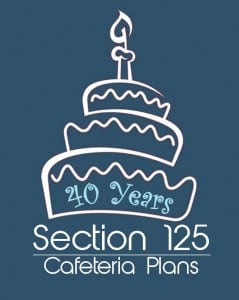Home / Blog / Section 125 Plans as Social Policy
Section 125 Plans as Social Policy
 Reading the law for Section 125 Plans (26 U.S. Code § 125), you find the words ‘highly compensated individual,’ ‘key employee,’ and ‘discrimination.’ That’s because the original purpose of the cafeteria plan rules set up under Section 125 was more about social policy than tax savings.
Reading the law for Section 125 Plans (26 U.S. Code § 125), you find the words ‘highly compensated individual,’ ‘key employee,’ and ‘discrimination.’ That’s because the original purpose of the cafeteria plan rules set up under Section 125 was more about social policy than tax savings.
According to Tax Policy as Social Policy: Cafeteria Plans, 1978-1985, “The purpose of the strategy was to improve the benefits, including health benefits, available to lower-paid workers (Fox & Schaffer, 1987).
Cafeteria plans pre-1978
Section 125(d)(1)(b) of the Code defines a cafeteria plan as a “written plan” wherein employees “may choose among 2 or more benefits consisting of cash and qualified benefits.”
Employers had been offering cafeteria plans to employees for years. Presented a menu-like list of benefit options and a set dollar amount available from the employer, workers would pick and choose the benefits they wanted for the year — or they’d choose to take the cash with fewer or no benefits at all.
Policymakers in Washington D. C. were troubled by the lopsided results. Higher-paid employees were taking a more complete benefit package than lower-income workers. In fact, most lower-income workers were choosing the additional salary offered in the cafeteria plan to make ends meet.
This left those workers without health insurance, additional life and accident insurance, flexible spending accounts, and more. Employees choosing cash over benefits (and their families) were far more vulnerable when illness or crises came along than were those choosing to purchase the benefits with the cash.
Non-discrimination in health benefits
In early 1978, the Treasury began working with Congress on that year’s tax bill. In exchange for favorable treatment of a tax policy known as “constructive receipt,” which governed in which tax year deferred income would be taxed, Congress would enact the Treasury’s desired non-discrimination rules.
Non-discrimination rules for Section 125 plans would not only require employers to offer equal coverage choices to all employees but to monitor the use of those benefits. This is to ensure that a cafeteria plan was set up to be affordable to all workers in the company.

Tax incentives for workers, too
There was also a new incentive to employees for choosing a more comprehensive benefit plan instead of additional income.
Prior to the 1978 addition of Section 125 to the Code, employers deducted the cost of benefits offered to employees as a tax-exempt business expense, just as they do today. Employees were not so fortunate. Anything the employee received from the employer in a cafeteria plan or by other means was counted as taxable income at tax time. Employees could deduct qualifying amounts from their taxable income as a medical expense tax deduction, but this was usually far less than the taxes paid on those dollars.
Concerned that “employees needed an incentive to provide for their retirement, sickness, disability, etc.,” policymakers added another provision1 to Section 125 plans. Under the new rules, additional compensation used to purchase qualified benefits becomes tax-deductible; cash taken in lieu of benefits remains taxable income.
Section 125 Plans: A big win-win for everyone
Pretty much everyone agreed this was a great idea, although for different reasons. Employers and employees got a tax break, and lower-paid workers were as likely to have health insurance as their higher-paid colleagues.
The basic framework of Section 125 plans remains today. First, it must be a written plan document. It must not discriminate in any way, meaning it has to be offered to all employees on an equal basis and must be used by all employees in a way that it does not appear to discriminate in favor of highly compensated or key employees. And, employees pay for benefits with a pre-tax salary deduction. In that way, overall payroll expense is reduced and the employer eliminates their share of the related Social Security and Medicare tax. It’s a big win-win for everyone involved!
More in the Section 125 Plan’s 40th birthday series:
Learn more about Section 125 Plan non-discrimination testing:
1Fox, D. and Schaffer, D. Tax Policy as Social Policy: Cafeteria Plans, 1978-1985. (1987). In C. Rist (Ed.) Policy Issues for the 1990’s. (1980). Retrieved from https://books.google.com/books